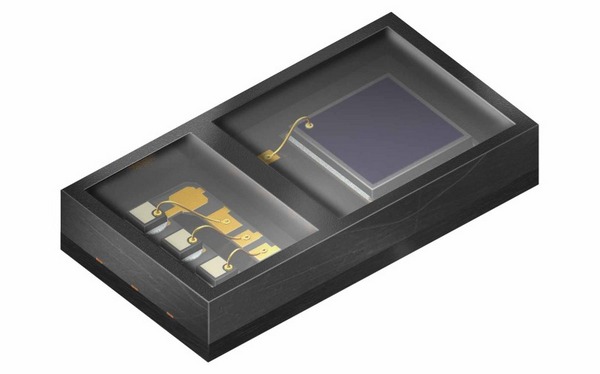Osram Opto has released new green LED products specifically designed for heart monitoring. The green LEDs for heart rate monitoring are probably similar to the ones used in Apple Watch for heart rate tracking. The mechanism used to measure heart rate is similar, in which it relies on measuring light absorbed by blood vessels and surrounding tissues. For further details about the new green LEDs please see Osram Opto’s full press release below:
Semiconductors is expanding its portfolio for fitness tracking applications
The SFH 7051 from Osram Opto Semiconductors is an integrated optical sensor specially designed for heart rate monitoring. This component is used in fitness trackers, smart watches and other wearables. The new sensor consumes very little power, thereby maximizing battery life.
The SFH 7051 consists of a large-format photo diode and three green LEDs with a wavelength of 530 nanometers (nm). It is used for monitoring heart rate by measuring the volume of blood passing through blood vessels. It works by shining light on the surface of the skin. Different amounts of this light are absorbed by blood and the surrounding tissue. The light not absorbed is reflected to the detector. With its green emission spectrum the SFH 7051 is ideal for measuring the pulse rate at the wrist.
 |
|
Osram Opto's green LEDs for heart rate monitoring in wearable devices is probably similar to those found on the Apple Watch. (Osram/LEDinside) |
High-efficiency chips for low power consumption
The green emitter chips of the SFH 7051 are based on the latest high-efficiency UX:3 chip technology from Osram Opto Semiconductors. The sensor uses three of these chips so that they can be operated at the optimum current of 20 milliamperes (mA). At this operating current the efficiency of the emitters is particularly high. Overall, SFH 7051 produces an optical output of 3 x 3.4 milliwatts (mW) at a current of 20 milliamperes and a voltage of 3.2 V. The low power consumption of the component means long battery life in the device. With an area of only 1.7 mm2, the photodiode is small enough to enable the sensor to be compact, but sensitive enough to offer the required signal quality. Its low capacitance of only 11 picofarads ensures short switching times and high measuring frequency.
Enlarging the portfolio for medical self-monitoring
SFH 7051 is the second integrated optical sensor from Osram for fitness tracking applications. In 2014, the company launched the SFH 7050, a multifunction sensor for measuring heart rate and the oxygen content of blood. “We are keeping a very close watch on the trend for medical self-monitoring based on wearables”, said Dr. Jörg Heerlein, Senior Manager Product Marketing at Osram Opto Semiconductors. Wearables are electronic devices that are worn on the body, such as smart watches and fitness wristbands. “The SFH 7051 meets the need of our customers for a separate solution specifically for heart rate monitoring.” Users have a choice between the multifunction SFH 7050 and the SFH 7051 which is optimized for pulse rate monitoring. The housing dimensions of the two sensors are identical.
|
Technical data:
|
|
Dimensions
|
4.7 mm x 2.5 mm x 0.9 mm
|
|
Wavelength
|
530 nm
|
|
Optical output at 20 mA
|
3 x 3.4 mW
|
|
Beam angle
|
±60 °
|
|
Photo-sensitive area
|
1.7 mm2
|
|
Spectral sensitivity at 530 nm
|
0.26 A/W
|












